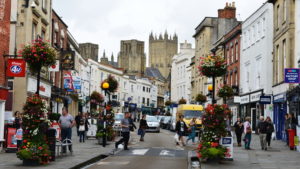
The number of empty shops in town centres and shopping malls fell again in the first three months of the year, but there are still significantly more than there were before the pandemic.
During the third lockdown early last year, 14.5 per cent of the shops in Britain lay empty, according to data compiled by the British Retail Consortium and the Local Data Company. That figure dipped to 14.4 per cent towards the end of 2021 and fell again to 14.1 per cent in the first quarter of this year, according to their latest report. The closures include shops on high streets, in shopping centres and on retail parks.
It is the first time since the spring of 2016 that the overall vacancy rate has fallen in consecutive quarters and is the biggest quarter-on-quarter decline since the consortium started collecting the data in 2015.
However, there are still far more empty shops than there were before the coronavirus outbreak began, when the vacancy rate stood at about 12 per cent.
Helen Dickinson, chief executive of the consortium, said the improvement was because “the economy had fully reopened, with more city workers back in the office and more tourists out on the streets”. The BRC noted that there was “uncertainty ahead”, given the surging cost of living and the war in Ukraine, which have contributed to depressing consumer confidence to its lowest level since the global financial crisis in 2008.
Vacancy rates at all types of retail location improved in the first quarter. Shopping centres have always had a greater proportion of empty shops than elsewhere, a trend exacerbated by the pandemic. Just over two years ago, about 14 per cent of the retail units in Britain’s malls were unoccupied, whereas 19 per cent of them are now. However, that is down from 19.1 per cent in December and from 19.4 per cent last summer.
Vacancy rates on high streets fell to 14.1 per cent, having peaked at 14.5 per cent in the second quarter of last year. Retail parks remain the most popular destination for retailers, with an average vacancy rate of 10.6 per cent, down from 11.5 per cent a year ago.
The biggest fall in vacancy rates came in the northeast, but at 18.8 per cent it still has the highest proportion of boarded-up stores in the country. In London, the vacancy rate nudged up to 11.1 per cent from 11 per cent, although it remains the region with the smallest proportion of shuttered shops.
Read more:
Fewer empty high street shops after reopening of economy





